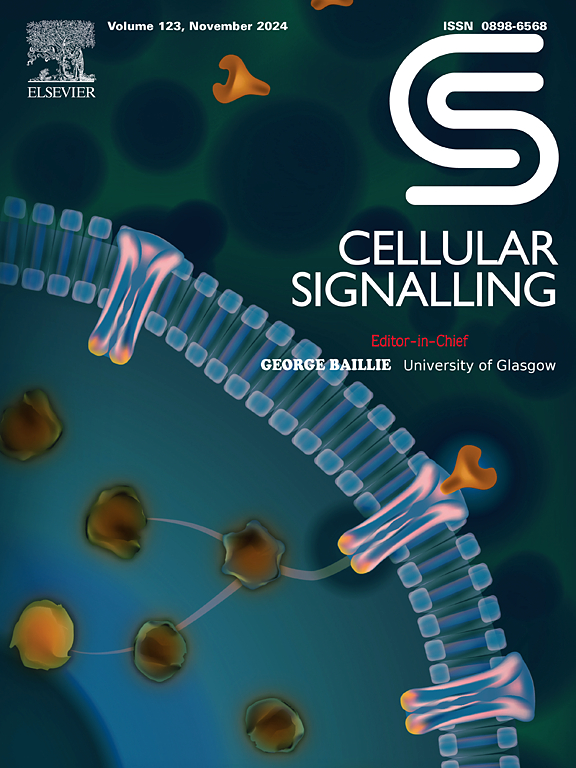胆绿素通过调节 P4hb/MAPK/mTOR通路抑制自噬减轻脑缺血再灌注损伤
IF 4.4
2区 生物学
Q2 CELL BIOLOGY
引用次数: 0
摘要
背景胆绿素(BV)具有抗炎和抗氧化作用。自噬激活在脑缺血再灌注损伤(CIRI)的发病机制中至关重要。本研究旨在探讨白藜芦醇是否能通过调节自噬来改善脑缺血再灌注损伤。方法采用Sprague-Dawley(SD)大鼠大脑中动脉闭塞再灌注(MCAO/R)模型和PC12细胞氧-葡萄糖剥夺/再氧合(OGD/R)模型来探讨白藜芦醇的神经保护作用及其内在机制。在这些大鼠中,一旦在 MCAO/R 后给予 BV,就会通过行为学、形态学和分子分析来评估其治疗效果和内在机制。另外,对于 PC12 细胞,在成功进行 OGD/R 建模后,应用 BV、自噬激活剂雷帕霉素、脯氨酰 4- 羟化酶 beta(P4hb)敲除或过表达,以及三种经典自噬途径的特异性抑制剂。随后进行了细胞活力(使用 CCK8 检测法)、Calcein/PI 染色、自噬体染色(使用 MDC 检测法)、逆转录定量聚合酶链反应和 Western 印迹,以研究 BV 改善 CIRI 的机制。进一步研究表明,BV 下调了 P4hb 的表达。体外实验表明,P4hb 的敲除减少了 CIRI 后细胞的自噬,而其过度表达则逆转了 BV 的影响。结论BV通过调节P4hb/MAPK/mTOR信号通路来抑制自噬,从而改善CIRI,为缺血性中风提供了一种新的治疗策略。本文章由计算机程序翻译,如有差异,请以英文原文为准。

Biliverdin alleviates cerebral ischemia-reperfusion injury by regulating the P4hb/MAPK/mTOR pathway to inhibit autophagy
Background
Biliverdin (BV) exhibits anti-inflammatory and antioxidative effects. Autophagy activation is crucial in the pathogenesis of cerebral ischemia-reperfusion injury (CIRI). This study aimed to investigate whether BV could ameliorate CIRI by regulating autophagy.
Methods
A middle cerebral artery occlusion-reperfusion (MCAO/R) model in Sprague-Dawley (SD) rats and an oxygen-glucose deprivation/reoxygenation (OGD/R) model in PC12 cells were employed to explore the neuroprotective effects of BV and its underlying mechanisms. In these rats, once BV was administered post-MCAO/R, its treatment efficacy and underlying mechanisms were evaluated through behavioral, morphological, and molecular analyses. Alternatively, for PC12 cells, following successful OGD/R modeling, BV, autophagy activator rapamycin, prolyl 4-hydroxylase beta (P4hb) knockdown or overexpression, and the specific inhibitors of three classic autophagy pathways were applied. Cell viability (using CCK8 assay), Calcein/PI staining, autophagosome staining (using MDC assay), reverse transcription quantitative polymerase chain reaction, and western blot were subsequently carried out to investigate the mechanisms by which BV ameliorates CIRI.
Results
BV alleviated CIRI by inhibiting autophagy. Further investigation suggested that BV downregulated P4hb expression. In vitro experiments showed that P4hb knockdown reduced autophagy in post-CIRI cells, while its overexpression reversed the effects of BV. Rescue experiments indicated that MAPK pathway inhibitors counteracted the effects of P4hb overexpression on autophagy post-CIRI.
Conclusion
BV improves CIRI by regulating the P4hb/MAPK/mTOR signaling pathway to inhibit autophagy, offering a novel therapeutic strategy for ischemic stroke.
求助全文
通过发布文献求助,成功后即可免费获取论文全文。
去求助
来源期刊

Cellular signalling
生物-细胞生物学
CiteScore
8.40
自引率
0.00%
发文量
250
审稿时长
27 days
期刊介绍:
Cellular Signalling publishes original research describing fundamental and clinical findings on the mechanisms, actions and structural components of cellular signalling systems in vitro and in vivo.
Cellular Signalling aims at full length research papers defining signalling systems ranging from microorganisms to cells, tissues and higher organisms.
 求助内容:
求助内容: 应助结果提醒方式:
应助结果提醒方式:


